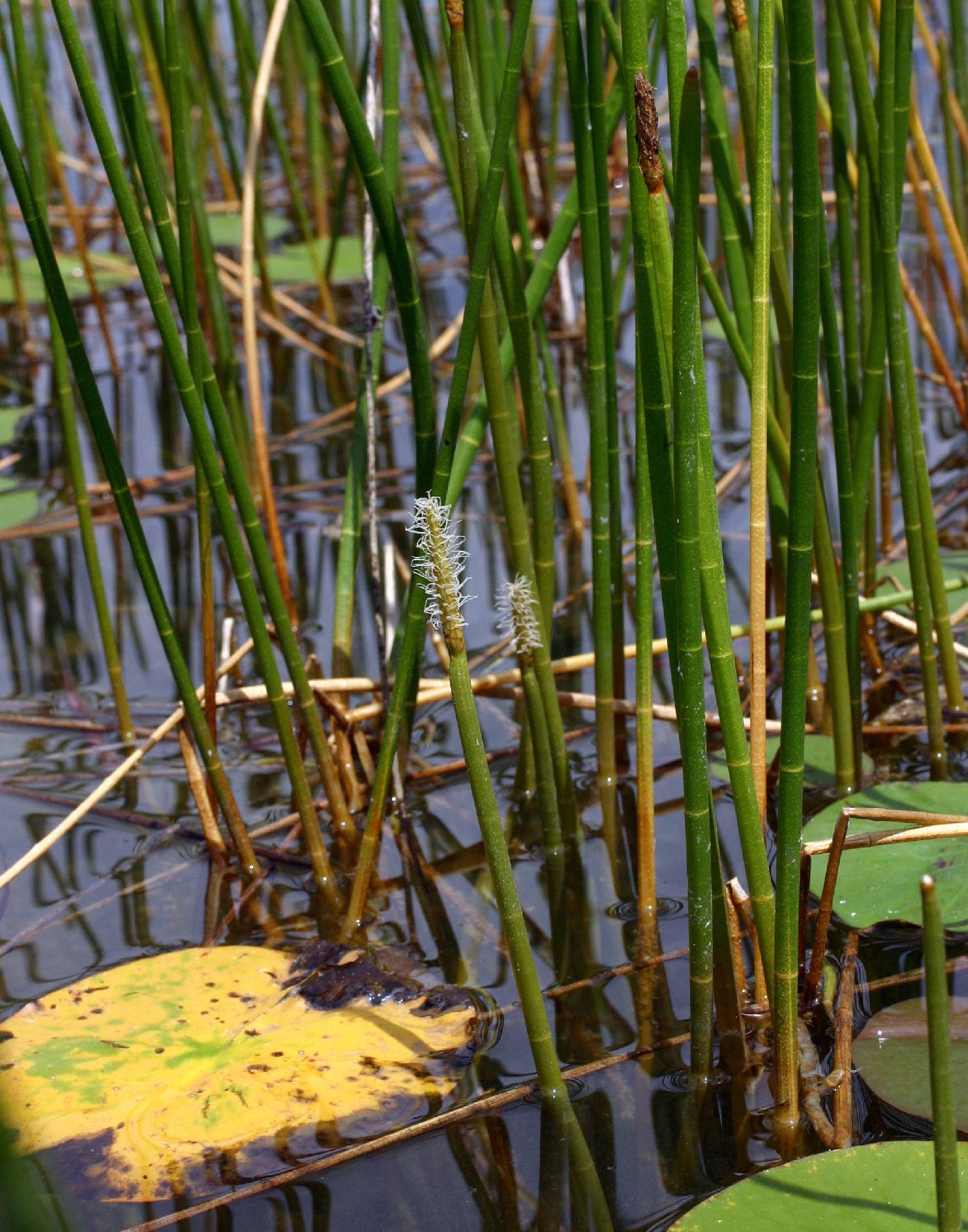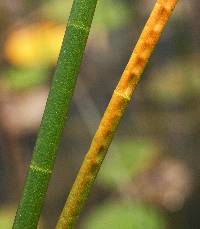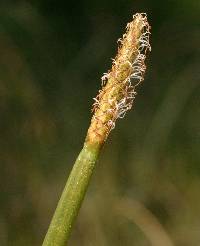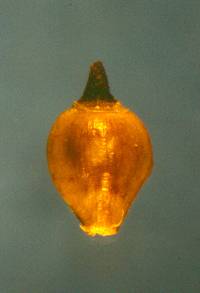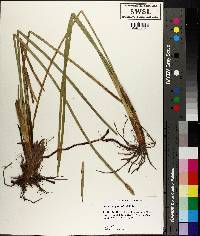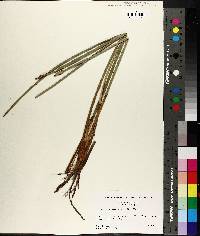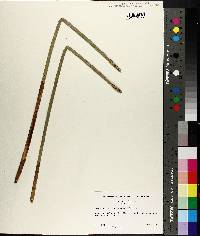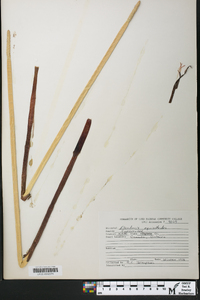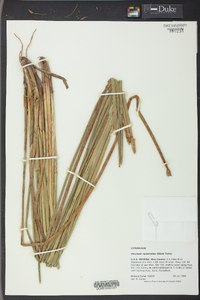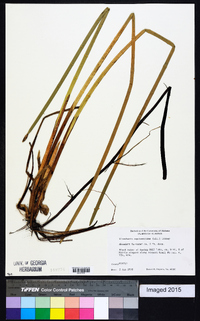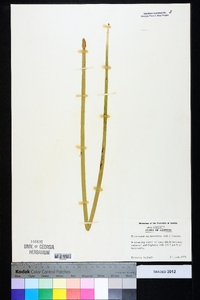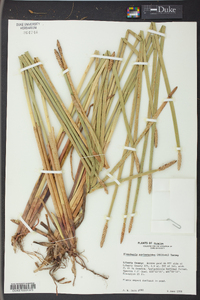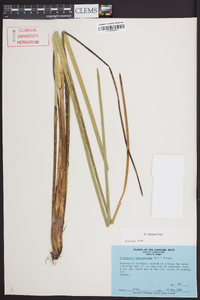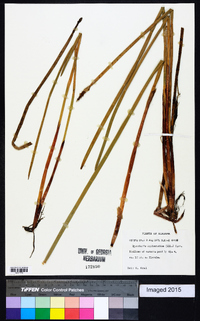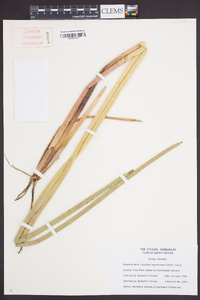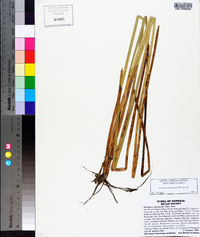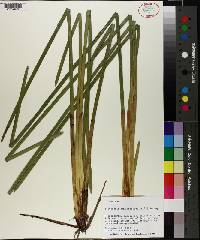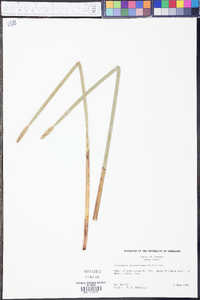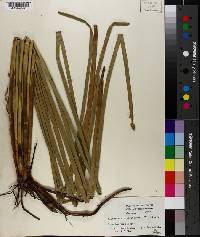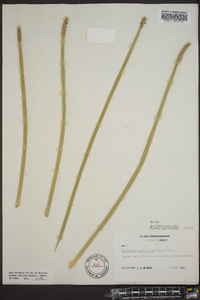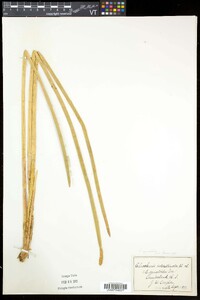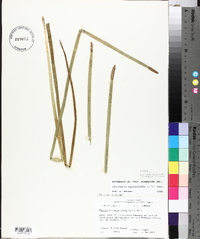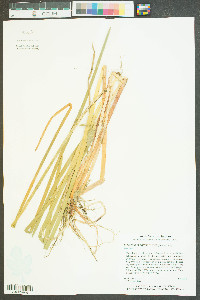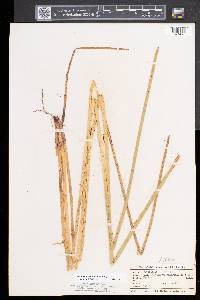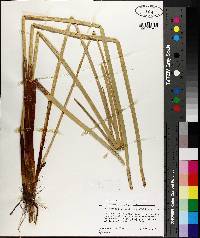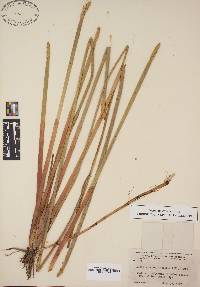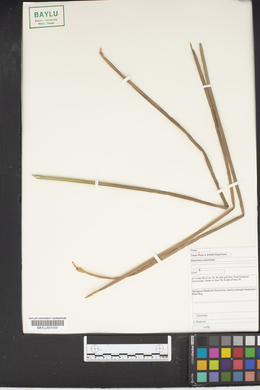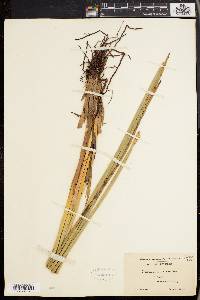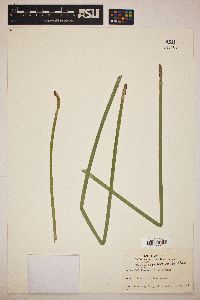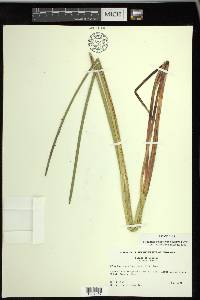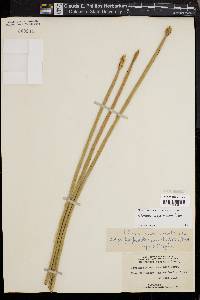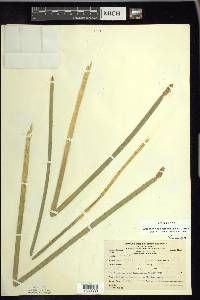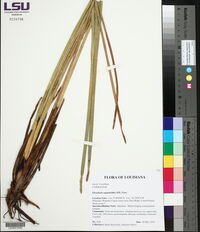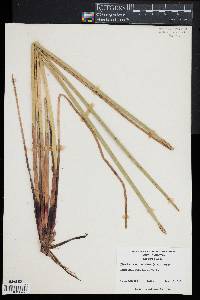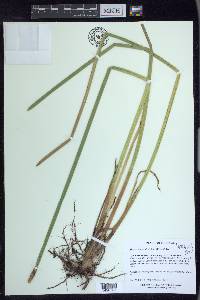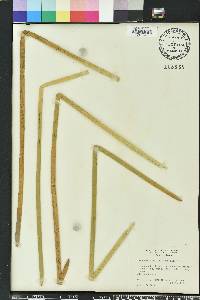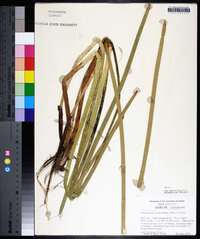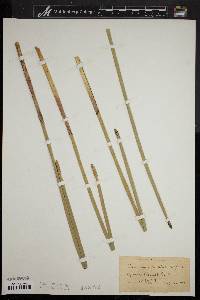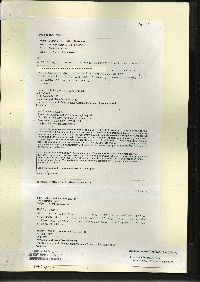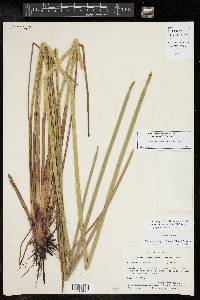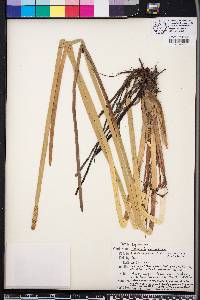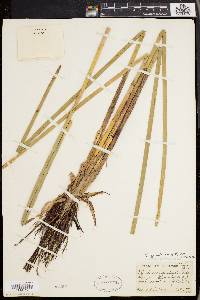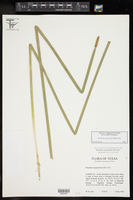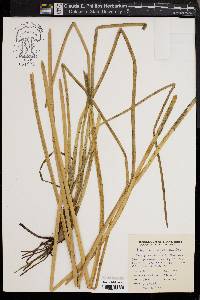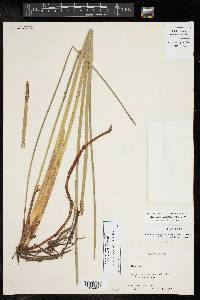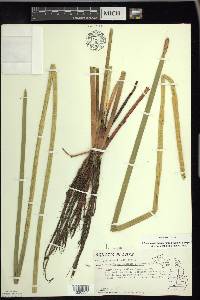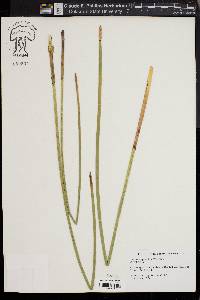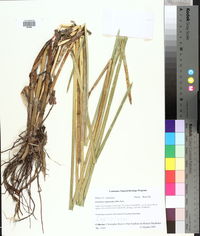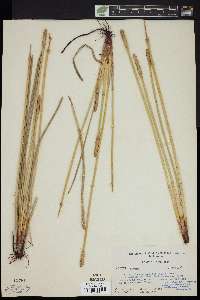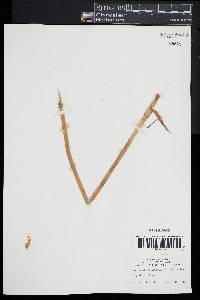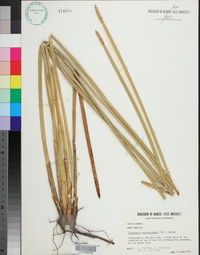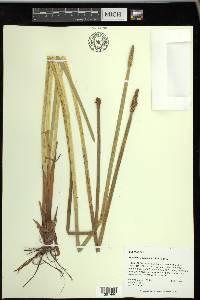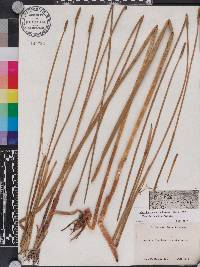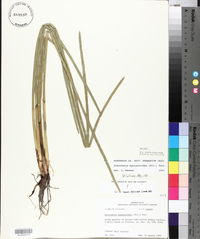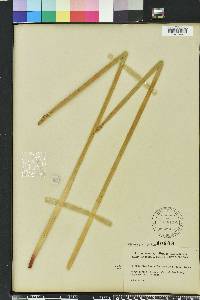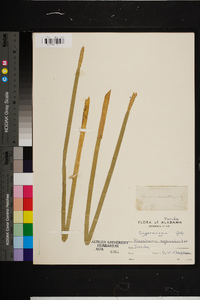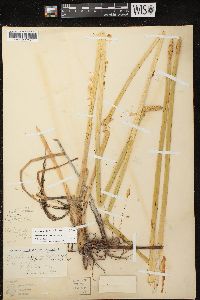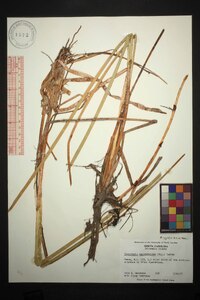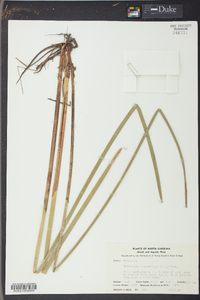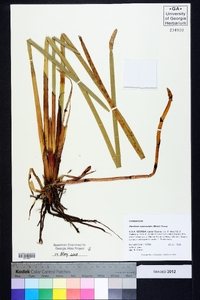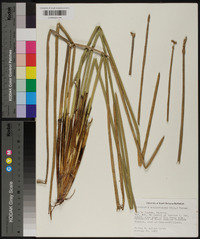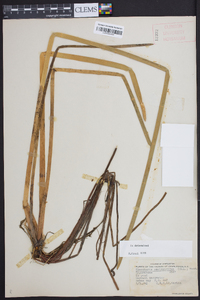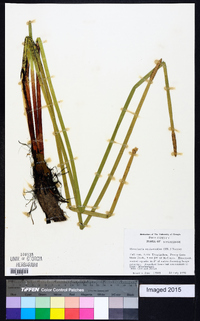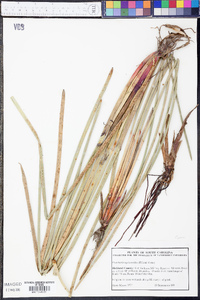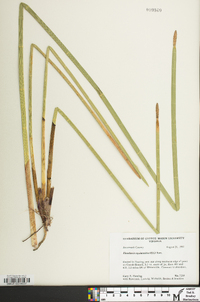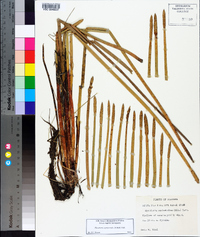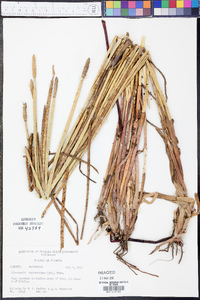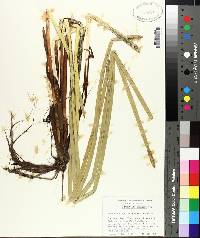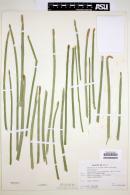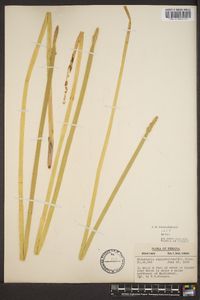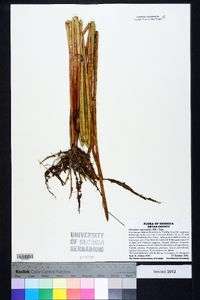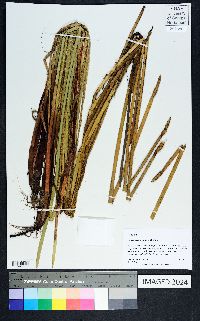
|
|
|
|
Family: Cyperaceae
Horsetail-Spike-Rush
|
Plants perennial; rhizomes 2-4 mm thick, soft to firm, longer internodes 2-8 cm, scales persistent, 7-8 mm, membranous, tubers absent. Culms terete, 50-100 cm × 5-8.4 mm, soft to firm, obscurely to clearly septate-nodulose throughout, internally hollow with complete transverse septa, closer together near the spikelet; plants never forming filiform, flaccid culms. Leaves: distal leaf sheaths persistent, membranous to thinly papery, apex acute to slightly acuminate. Spikelets not proliferous, 20-45 × 4-5(-8) mm; rachilla joints bearing prominent winglike remnants of floral scales; proximal scale empty, amplexicaulous, (2-)2.8-4.9 mm; floral scales 85-160, 1-3 per mm of rachilla, stramineous to pale brown, usually with pale to dark brown submarginal band, obovate to oblong, (4.8-)5.2-7 × 3-4.4 mm, cartilaginous, often membranous toward margins, margins broadly translucent, membranous, apex rounded to obtuse. Flowers: perianth bristles 3-8, stramineous to reddish, slender, vestigial to 2.5 mm, shorter than to equaling achene, smooth or obscurely retrorsely spinulose; anthers stramineous to red-striated, 2.6-3.2 mm; styles 2-3-fid. Achenes yellowish to reddish brown, obovoid, biconvex to obscurely compressed trigonous, 1.8-2.3 × 1.4-1.9 mm, obscurely sculptured or sometimes partially smooth at 10-15X, each face with 20-40 rows of linear, transversely elongated cells, lines separating cells obscure, apex with very short neck 0.6-0.8 mm wide. Tubercles dark brown, lamelliform, high-deltoid, 0.6-1.1 × 0.5-0.7 mm. Fruiting late spring-late fall. Fresh ponds, lakes, marshes, streams, ditches, cypress swamps; 10-500 m; Ont.; Ala., Calif., Conn., Fla., Ga., Ind., La., Md., Mass., Mich., Miss., Mo., N.Y., N.C., R.I., S.C., Tex., Va., Wis. We have not seen voucher specimens for reports of Eleocharis equistoides from Arkansas and Tennessee. It is probably extirpated from Illinois, Missouri, and Wisconsin. Contrary to previous decriptions, sectioning of the culm reveals that the distance between the septa near the spikelet cannot be used to distinguish the two septate species, E. equisetoides and E. interstincta, which when achenes are absent are better distinguished by the septate-nodulose distal parts of the culms of E. equisetiodes.
Perennial herb with slender rhizomes 0.5 - 1 m tall Leaves: reduced to bladeless sheaths, basal, two per culm, margins fused and enclosing culm, with a more or less pointed apex, papery to membranous. Flowers: minute, spirally arranged on the axis of the spikelet, lacking sepals and petals, with three to eight bristles, subtended by a scale. Bristles straw-colored to reddish, equal to or shorter than the achene, slender, crooked. Stamens three, exserted. Anthers straw-colored to red-streaked, to over 3 mm long. Pistil one. Style two- to three-cleft. Fruit: a one-seeded achene, golden brown to reddish brown, about 2 mm long and 1.5 mm wide, reverse egg-shaped, lenticular (lens-shaped) to compressed and three-angled, somewhat smooth to obscurely sculptured (at 10-15X). Tubercle dark, tiny, triangular, flattened. Seed with a thin, non-adherent wall. Culm: upright, unbranched, 0.5 - 1 m long, 5 - 8.5 mm wide, circular in cross-section, jointed, hollow with transverse partitions (septa), enclosed basally by two fused sheaths. Spikelets: solitary, 1.5 - 4.5 cm long, 4 - 5 mm wide, cylindrical with a pointed apex, with 85 to 160 floral scales. Scales spirally arranged and overlapping, straw-colored to light brown with a submarginal band and translucent margin, dotted with purple inside, 5 - 7 mm long (bottom scale 2.5 - 4.9 mm long), 3 - 4.5 mm wide, reverse egg-shaped to oval with a blunt to rounded apex. Wing-like remnants of floral scales are found in the joints of the spikelet axis. Similar species: No information at this time. Flowering: July to October Habitat and ecology: Probably extirpated from the Chicago Region. Found in moist areas, often near lakes and ponds. Occurence in the Chicago region: native Etymology: Eleocharis comes from the Greek words heleios, meaning "dwelling in a marsh," and charis, meaning grace. Equisetoides means "like Equisetum (horsetail)." Author: The Morton Arboretum Rhizomatous perennial; stems to 1 m, 5 mm thick, cross-septate at intervals of 2-5 cm; spikelet cylindric, 1.5-3 cm, about as thick as the stem; scales oval, obtuse to broadly rounded, scarious-margined, purple-dotted inside; bristles few, crooked, weak, up to as long as the achene; style trifid or bifid; achene biconvex, obovoid, golden-brown, 2 mm; tubercle dark, flattened, triangular, 1 mm. Shallow water; near the coast from Mass. to Fla., w. to Wis., Mo., and Tex. (E. interstincta, misapplied) Gleason, Henry A. & Cronquist, Arthur J. 1991. Manual of vascular plants of northeastern United States and adjacent Canada. lxxv + 910 pp. ©The New York Botanical Garden. All rights reserved. Used by permission. From Flora of Indiana (1940) by Charles C. Deam In shallow water on the sandy bottoms of some of our northern lakes. ...... Indiana Coefficient of Conservatism: C = 10 Wetland Indicator Status: OBL |
|
|
|
This project was made possible in part by the Institute of Museum and Library Services [MG-70-19-0057-19].
Powered by Symbiota

